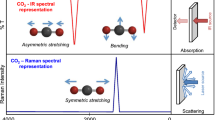Abstract
The intrinsic fluorescence of Triton X-114 and Igepal CO-630 was used to monitor the aggregation behavior of micellar solutions of these surfactants. The response to changes in surfactant concentration, increases in temperature up to and beyond the cloud point, and addition of an ionic surfactant (SDS) was monitored. The intrinsic fluorescence was used to measure aggregate anisotropy as a function of SDS concentration and temperature. Relative aggregate abundance showed a minimum at the CMC, confirming the existence of premicellar assemblies. Structural differences in the hydrophobic portions of the two nonionic surfactants led to vastly different packing in their aggregates. The addition of SDS produced smaller, more closely packed micelles.
Similar content being viewed by others
References
F. Grieser and C. J. Drummond (1988)J. Phys. Chem. 92, 5580–5593.
R. von Wandruszka (1992)Crit. Rev. Anal. Chem. 23, 187–215.
G. Komaromy-Hiller and R. von Wandruszka (1995)J. Phys. Chem. 99, 1436–1441
D. Myers (1992)Surfactant Science and Technology, 2nd ed, VCH, New York.
S. Ikeda and G. D. Fasman (1970)J. Polym. Sci. 8, 991–1001.
J. R. Lakowicz (1983)Principles of Fluorescence Spectroscopy, Plenum Press, New York, p. 112.
R. Perrin (1926)J. Phys. Radium 7, 390.
J. R. Lakowicz,Principles of Fluorescence Spectroscopy, Plenum Press, New York, Chap. 5.
K. Kalyanasundaram (1987)Photochemistry in Microheterogeneous Systems, Academic Press, Orlando, FL, p. 194.
H. Schott, A. E. Royce, and S. K. Han (1984)J. Colloid Interface Sci. 98, 196–201.
B. S. Valaulikar and C. Manohar (1985)J. Colloid Interface Sci. 108, 403–406.
M. Corti and C. Minero (1984)J. Phys. Chem. 88, 309–317.
L. Marszall (1988)Langmuir 4, 90–93.
W. L. Hinze and E. Pramauro (1993)Crit. Rev. Anal. Chem. 24, 133–177.
G. G. Guilbault (1990)Practical Fluorescence, 2nd ed., Marcel Dekker, New York, p. 14.
D. Myers,Surfactant Science and Technology, 2nd ed, VCH, p. 91.
T. T. Ndou and R. von Wandruszka (1990)J. Luminesc. 46, 33–38.
D. Myers,Surfactant Science and Technology, 2nd ed, VCH, p. 232.
J. R. Lakowicz,Principles of Fluorescence Spectroscopy, Plenum Press, New York, p. 133.
G. Komaromy-Hiller and R. von Wandruszka (1996)Colloid Interface Sci. 177, 156–161.
Author information
Authors and Affiliations
Rights and permissions
About this article
Cite this article
McCarroll, M.E., von Wandruszka, R. Surfactant fluorescence in the study of aggregation and clouding. J Fluoresc 7, 185–193 (1997). https://doi.org/10.1007/BF02758218
Received:
Accepted:
Issue Date:
DOI: https://doi.org/10.1007/BF02758218




